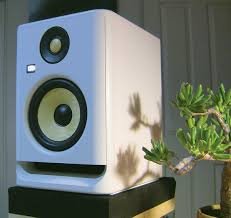When it comes to choosing studio monitors, we often find ourselves torn between popular options. Today, we’re diving into the age-old debate of Yamaha HS5 vs KRK Rokit 5. As fellow music producers, we know how crucial it is to have reliable monitors that accurately represent our mixes. These two powerhouses have been staples in home studios for years, each with its own loyal following.
In this comparison, we’ll break down the key differences between the Yamaha HS5 and KRK Rokit 5. We’ll explore their bass response, mid-range clarity, and high-frequency performance. We’ll also look at how they perform in different room sizes and offer placement tips to get the best sound. By the end, you’ll have a clear idea of which monitor suits your needs best, helping you make an informed decision for your studio setup.
Bass Response and Low-End Performance
When it comes to bass response, both the KRK Rokit 5 and Yamaha HS5 have their unique characteristics. Let’s dive into how these monitors handle the low end and see which one might be the better fit for your studio.
KRK Rokit 5 Bass
We’ve found that the KRK Rokit 5 G4s really pack a punch in the low-end department. With a frequency response reaching down to 43Hz, these little powerhouses deliver an impressive amount of bass for their size. The sound is full, even, and surprisingly punchy. It’s quite remarkable how these compact speakers manage to produce such a strong and balanced low-end.
However, it’s worth noting that as we crank up the volume, the woofer can start to show signs of distortion. This distortion tends to increase gradually with volume, which we actually prefer over speakers that suddenly break up badly at higher levels.
Yamaha HS5 Bass
The Yamaha HS5, on the other hand, takes a different approach to bass reproduction. These monitors have a unique voicing in the low-end, with a shallow roll-off starting in the low midrange. The midbass to low midrange region sits at -3dB, and there’s a rapid roll-off starting at 80Hz.
At first glance, this might seem like a drawback, but we think it’s actually a clever design choice by Yamaha. This voicing helps the HS5s sound more neutral in untreated rooms, which is a common scenario for many home studios. In our experience, these monitors showed very little bass peaking in lightly treated rooms compared to other ported monitors we’ve tested.
Subwoofer Compatibility
Given the size limitations of both monitors, you might want to consider pairing them with a subwoofer for extended bass response. This is especially true if you’re working on bass-heavy genres or in larger rooms.
For the KRK Rokit 5, you have several subwoofer options within the KRK family. These range from the S8.4 with its 29Hz extension to the 12sHO, which reaches down to a bone-rattling 23Hz.
With the Yamaha HS5, adding a subwoofer might be even more beneficial, especially in well-treated rooms where its built-in bass roll-off becomes more noticeable. Just keep in mind that calibrating the HS5 with a subwoofer might require some extra attention due to its unique bass response.
Mid-range and High Frequency Clarity
When it comes to the mid-range and high frequencies, both the KRK Rokit 5 and Yamaha HS5 have their unique characteristics. Let’s dive into how these monitors handle these crucial frequency ranges.
KRK Rokit 5 Mids and Highs
We’ve noticed that the KRK Rokit 5 G4s have a distinctive mid-range response. Many users report that commercial CDs tend to sound more mid-forward on these monitors compared to other systems. This can be a double-edged sword. On one hand, it might make your mixes sound rich and present. However, we’ve found that if we EQ our projects to sound good on the Rokits, they can end up sounding thin and lacking presence on other systems.
The high frequencies on the Rokit 5 are clear and detailed. We’re impressed by how even the sound is across the frequency range. There’s a seamless transition between the woofer and tweeter, resulting in a cohesive sound that’s great for modern, punchy productions.
Yamaha HS5 Mids and Highs
The Yamaha HS5, true to its heritage, offers exceptional balance across the frequencies. While it might not match the Rokit 5 G4 in low-end, its midrange and highs shine with clarity. We’ve found that the HS5’s mid-range is more controlled, which can be crucial for accurate mixing.
Yamaha has developed new transducers for the HS series that achieve an astonishingly smooth response over a wide bandwidth. This technology, combined with their advanced magnetic field design, provides seamless, natural sonic transitions.
Vocal and Instrument Reproduction
When it comes to vocal and instrument reproduction, both monitors have their strengths. The KRK Rokit 5’s mid-forward tendency can make vocals and certain instruments pop in the mix. However, we’ve found that this can sometimes lead to overcompensation in the mixing process.
The Yamaha HS5, on the other hand, excels in reproducing vocals and acoustic instruments with exceptional clarity. Its balanced mid-range and crisp highs make it particularly well-suited for genres like classical or acoustic music where precision and detail are paramount.
In our experience, the Yamaha HS5 edges out the KRK Rokit 5 in overall sound quality, but only by a small margin. The HS5’s sound is more controlled and slightly more refined, making it a great choice for those who prioritize accuracy in their mixes.
Room Size and Placement Considerations
When it comes to setting up our KRK Rokit 5 or Yamaha HS5 monitors, proper placement is crucial for achieving the best sound. We’ve found that room size and speaker positioning can significantly impact the overall listening experience.
KRK Rokit 5 Placement
We’ve noticed that the KRK Rokit 5 tends to be a bit bass-heavy, which can be great for certain types of music production. However, this characteristic can be misleading when mixing. To get the most accurate sound, we recommend placing these monitors at least 1.5 meters away from walls or corners. This helps prevent excessive bass buildup.
If we’re working in a smaller room and can’t achieve this distance, we can use the built-in ROOM CONTROL switch to compensate for the bass boost. As we move the speakers closer to walls or corners, we might need to adjust this setting from [0] to [-2] or even [-4] to achieve a more natural sound.
Yamaha HS5 Placement
For the Yamaha HS5, we’ve found that symmetrical placement is key. We try to position the left and right speakers equidistant from their respective side walls and the rear wall. This setup helps create a balanced stereo image.
To get the most accurate monitoring, we form an equilateral triangle with the speakers and our listening position. We angle the speakers inward, facing us directly. We’ve also learned that it’s crucial to have the tweeters at ear level when we’re seated at our mixing position.
Acoustic Treatment
In our experience, even with optimal speaker placement, room acoustics play a significant role in sound quality. We’ve seen that untreated rooms can introduce unwanted reflections and resonances. To combat this, we recommend using acoustic panels or diffusers to manage reflections and improve overall sound clarity.
Conclusion and Recommendation
Both the KRK Rokit 5 and Yamaha HS5 have their strengths, catering to different needs in the studio. The Rokit 5 shines with its punchy bass and mid-forward sound, making it a solid choice for modern productions. On the other hand, the HS5 offers exceptional clarity and balance, which is crucial to achieve accurate mixes. Room size and proper placement play a big role in getting the best out of these monitors, with acoustic treatment being a key factor to consider.
In the end, the choice between these two monitors comes down to personal preference and the specific requirements of your studio setup. Whether you go for the KRK Rokit 5’s lively sound or the Yamaha HS5’s precision, both options provide quality tools to create professional-sounding mixes. Remember, the best monitor is the one that helps you make informed decisions about your music and translates well across different playback systems.
FAQs
1. How do the sound ranges of the Yamaha HS5 and KRK Rokit 5 compare?
The KRK Rokit 5 G4 has a broad frequency range from 43Hz to 40kHz, which is well-suited for genres that require deep bass and high treble, such as electronic music. In contrast, the Yamaha HS5 operates within a more restricted frequency range of 74Hz to 24kHz.
2. Are KRK monitors a good investment for audio monitoring?
KRK monitors are highly regarded for their reliability and clean sound performance, making them a valuable choice for both home studios and professional environments. Their affordability and versatility in delivering clear sound make them particularly popular.
3. What makes the Yamaha HS5 a recommended choice?
The Yamaha HS5 is praised for its excellent soundstage and exceptional imaging, considering its size and price point. The design is also a standout feature, particularly in the white version. Moreover, these speakers are noted for their impressive transient response, which is remarkable for monitors in their class.
4. What distinguishes the Yamaha HS5I from the HS5?
While the Yamaha HS5 is designed for standard use, the HS5I model includes additional mounting points on four surfaces, making it suitable for wall or ceiling installation.
This post may contain affiliate links. If you make a purchase through these links, we may earn a small commission at no additional cost to you.












